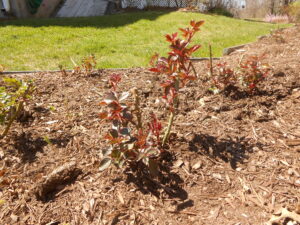March: An Early Start in the Rose Garden This Year
Views: 291

After a very mild winter with little snowfall, I was not too surprised to see that my roses broke dormancy a couple of weeks ago. The plants in my rose gardens went through the winter tall this year; usually I prune them ‘way down in the late fall. Once in a while this happens and when Spring arrives, there is a mad scramble to prune them back.
Mad Spring Scramble
Why the rush? When there is a bunch of new growth at the top of the bush, it can take away valuable energy from the plant because that top growth needs to be cut back to shape the bush. The last two weeks have been fairly sunny here, with temperatures in the 60’s and low 70’s. March sunshine is as intense as September sun, so the roses woke up early.
Other Signs of Early Spring
After eight months of above normal rainfall, the soil is finally drying out a little bit. Hollyhock seeds are sprouting. Maple seeds are pushing their caps up through the soil. Dandelions are up and setting buds, as is the chickweed. Early Spring bulbs are blooming. Delphiniums are pushing up higher every day. The soil is soaking up the sunshine and getting warmer every day. Hellebores are in full bloom, too.
Five Weeks Ahead of Schedule
There is an important message here. It is necessary to be in touch with your garden to know when to begin the gardening season in your area. We need to pay attention to what our roses are telling us and start accordingly rather than sticking to a calendar. Normally, I tell folks to begin pruning when the forsythia blooms, but not this year. (The forsythia buds are swelling, though…) Something else happened in my north-central Connecticut garden this past winter. The ground never froze! I just dug my dahlias about 10 days ago, and they are in buckets in the barn. They lived through the winter under the soil, unheard of in these parts.
Spring Clean-up
Once you begin Spring Pruning, you will send a clear message to your roses that they can start growing in earnest. Prune your hybrid teas and floribundas back to 18-24 inches, and cut back to an outward-facing bud so the new canes will grow away from the center of the plant. Be sure to cut back to green wood. Prune out any weak and insignificant growth that can’t support a healthy new cane. Trim back climbing roses closer to their structures. Shrub roses may be taken back at least 1/3 and shaped nicely. As you finish each section, be sure to rake out any debris from the winter and old, dry rose leaves from last year. If you had any black spot last year, lay down at least three inches of mulch in your beds early to help stop an infection this season. Any spores will be buried and will compost in the soil. Otherwise, the old dead leaves left under the roses can harbor fungus spores and when it rains, the spores will splash up on the undersides of the new leaves causing new black spot outbreaks. When your pruning is finished, use a drop of good old Elmer’s Glue to seal up the end of the cane so borers can’t drill through the canes.
And then…sit back and enjoy! I’m pretty sure there will be an early first flush for us in Connecticut this year!
Meet Marci Martin
Marci Martin has loved roses for as long as she can remember. From the time she was a little girl, she was fascinated with how…
Marci's Recent Posts

Beautiful Floribunda Roses








